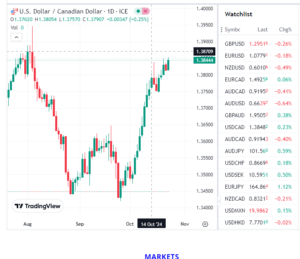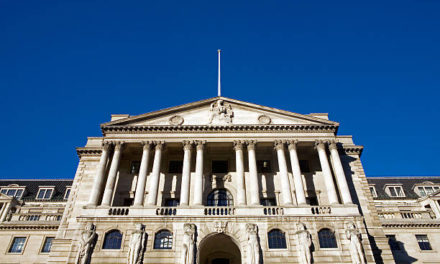Published October 23, 2024 11:35 am est
by Richard F. Cason, 
Editor in Chief,
NewsMovesmarketsForex
Key Issues-
- The BOC on Wednesday, October 23, 2024 Cut Interests by 50 Bases Points to 3.75%
- The CAD Continued to Weaken Against the USD after the News Release
- CAD weakened from 1.3831 to 1.3846 against the US dollar possibly indicating that investors sentiment about the implications of the rate cut on the Canadian economy
- Inflation Trends is a key factor influencing the Bank’s decision to cut rates is the recent decline in inflation. The Consumer Price Index (CPI) inflation dropped from 2.7% in June to 1.6% in September
- Looking ahead, the Bank of Canada forecasts gradual GDP growth, estimating 1.2% in 2024, rising to 2.1% in 2025, and 2.3% in 2026
- Inflation now relatively close to the Bank’s target of 2%, the decision to lower interest rates aims to maintain this stability while supporting growth
Bank of Canada Lowers Interest Rate by 50 BP’s to Stimulate Economic Growth
Ottawa, Ontario – October 23, 2024** – In a significant move aimed at stimulating Canada’s economy, the Bank of Canada out of Ottawa, Ontario – announced today that it has reduced its benchmark overnight interest rate by 50 basis points, bringing it down to 3¾%.
This decision is part of the Bank’s ongoing strategy to normalize its balance sheet while supporting economic growth and managing inflation.
Immediate Impact on the Canadian Dollar Currency

The announcement from the Bank of Canada had a notable impact on the USD/CAD exchange rate.
The Dollar continued strengthen against the CAD pair. Prior to the news release, the Canadian dollar (CAD) was trading at 1.3831 against the US dollar.
However, following the rate cut, the CAD weakened, with the exchange rate rising to 1.3846.
This decline suggests that investors reacted cautiously to the news, viewing the rate cut as a signal of potential economic challenges ahead, which may diminish the attractiveness of Canadian assets.
What Does This Mean of every Canadians
Understanding the Rate Cut For everyday Canadians, this interest rate cut means that borrowing money could become cheaper.
When the central bank lowers rates, financial institutions typically follow suit, which can lead to lower mortgage rates, less expensive loans for cars, and reduced credit card interest rates.
This may encourage more spending and investment, which is crucial for economic recovery.
Current Economic Landscape
The Bank’s decision comes against a backdrop of mixed economic signals both domestically and globally. The global economy is expected to grow at about 3% over the next two years, though the outlook varies by region.
The United States is projected to experience stronger growth than previously anticipated, while China’s economic activities remain sluggish.
In Europe, growth has been soft but is expected to show modest recovery next year. In Canada, the economy grew by approximately 2% in the first half of this year, with expectations of a slight slowdown to 1¾% in the latter half.
While consumer spending continues to rise, it is doing so at a slower pace per person.
The recent opening of the Trans Mountain Expansion pipeline has boosted exports, but the labor market shows signs of strain, with the unemployment rate standing at 6.5% as of September.
Inflation Trends
Inflation Trends is a key factor influencing the Bank’s decision to cut rates is the recent decline in inflation. The Consumer Price Index (CPI) inflation dropped from 2.7% in June to 1.6% in September.
Although shelter costs remain high, prices for other goods and services have softened, contributing to the overall decrease in inflation.
This shift has led the Bank to believe that inflationary pressures are stabilizing, allowing for a more aggressive stance on interest rates.
The Bank’s preferred measures of core inflation are now below 2½%, indicating that the broader inflation landscape is no longer as concerning as it once was.
With inflation now relatively close to the Bank’s target of 2%, the decision to lower interest rates aims to maintain this stability while supporting growth.
Future Economic Projections
Looking ahead, the Bank of Canada forecasts gradual GDP growth, estimating 1.2% in 2024, rising to 2.1% in 2025, and 2.3% in 2026.
This outlook suggests that as the economy rebounds, the excess supply currently present will gradually be absorbed, leading to more robust economic activity.
The Bank also anticipates that lower interest rates will help stimulate consumer spending and residential investment. As housing demand remains strong, spending on renovations and new home purchases is expected to rise.
Moreover, business investment is predicted to strengthen as overall demand increases, particularly from the United States. Cautious Optimism While the Bank is optimistic about the economic recovery, officials remain cautious.
They have indicated that any future rate cuts will depend on the unfolding economic conditions and their impact on inflation. The Bank is committed to making decisions based on the latest data, ensuring that they do not destabilize the economy.
Bank of Canada Strategic Outlook
Today’s interest rate cut by the Bank of Canada is a strategic move designed to support economic growth and maintain inflation around the target level.
However, the immediate reaction in the USD/CAD exchange rate reflects a bearish sentiment.
Instead of strengthening, the CAD weakened from 1.3831 to 1.3846 against the US dollar, indicating that investors may be concerned about the implications of the rate cut on the Canadian economy.
For Canadians, this means potentially lower borrowing costs and increased opportunities for spending.
As the global and domestic economic landscapes continue to evolve, the Bank of Canada will keep a close eye on developments, ready to adjust its policies as necessary to foster a stable and prosperous economy
For more Developing intriguing Central Bank Stories be sure to visit our Central Bank Breaking News Here:

News Moves Markets Forex “real time digital currency news”, works to provide market intelligence, connecting our audience with a mix of the most latest insightful currency news in the Foreign exchange markets. Providing the Latest and the greatest in depth developing global central bank stories and financial news to traders and investors around the continent.
Connecting People to the markets through the power of information from a Black perspective.
**Disclaimer** The information provided in this Central Bank currency news article is for informational purposes only and does not constitute financial advice, investment advice, or any other type of advice. The content is based on sources believed to be reliable; however, we make no guarantees regarding the accuracy, completeness, or timeliness of the information presented. Trading in foreign exchange (Forex) carries a high level of risk and may not be suitable for all investors. Past performance is not indicative of future results. You should carefully consider your financial situation, investment objectives, and risk tolerance before engaging in Forex trading. It is recommended that you seek independent financial advice from a qualified professional. We, the publishers of this article, shall not be held liable for any losses or damages arising from the use of this information or reliance on its accuracy. By reading this article, you acknowledge and accept this disclaimer in full.
**Disclaimer** The information provided in this Central Bank currency news article is for informational purposes only and does not constitute financial advice, investment advice, or any other type of advice. The content is based on sources believed to be reliable; however, we make no guarantees regarding the accuracy, completeness, or timeliness of the information presented. Trading in foreign exchange (Forex) carries a high level of risk and may not be suitable for all investors. Past performance is not indicative of future results. You should carefully consider your financial situation, investment objectives, and risk tolerance before engaging in Forex trading. It is recommended that you seek independent financial advice from a qualified professional. We, the publishers of this article, shall not be held liable for any losses or damages arising from the use of this information or reliance on its accuracy. By reading this article, you acknowledge and accept this disclaimer in full.







